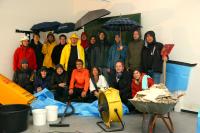Article,
Characterizing and Mining the Citation Graph of the Computer Science Literature
Knowledge and Information Systems, 6 (6): 664--678 (November 2004)
DOI: 10.1007/s10115-003-0128-3
Abstract
Citation graphs representing a body of scientific literature convey measures of scholarly activity and productivity. In this work we present a study of the structure of the citation graph of the computer science literature. Using a web robot we built several topic-specific citation graphs and their union graph from the digital library ResearchIndex. After verifying that the degree distributions follow a power law, we applied a series of graph theoretical algorithms to elicit an aggregate picture of the citation graph in terms of its connectivity. We discovered the existence of a single large weakly-connected and a single large biconnected component, and confirmed the expected lack of a large strongly-connected component. The large components remained even after removing the strongest authority nodes or the strongest hub nodes, indicating that such tight connectivity is widespread and does not depend on a small subset of important nodes. Finally, minimum cuts between authority papers of different areas did not result in a balanced partitioning of the graph into areas, pointing to the need for more sophisticated algorithms for clustering the graph.
Tags
- 10th
- 2012
- analysis
- characterizing
- citation
- citations
- citedby:doerfel2012publication
- computer
- dblp
- dependence
- graph
- icfca
- literature
- mining
- scientometry
Users
Comments and Reviewsshow / hide
- @jaeschke 13 years agoThe reported power-law exponent of 1.7 (Fig. 3) seems to be a bit low. [1] reports a value of 3, [2] states that the exponent α "typically lies in the range 2 < α < 3". I suspect that the authors provide the exponent for the cumulative distribution, which - according to [2] - differs from the "real" exponent by one. Hence, the exponent found in this work might be 2.7 which is closer to prior observations. [1] How popular is your paper? An empirical study of the citation distribution S. Redner European Physical Journal B 4(2):131--134 (August 1998) http://www.bibsonomy.org/bibtex/2e64d14f3207766f4afc65983fa759ffe/jaeschke [2] Power-Law Distributions in Empirical Data Aaron Clauset, Cosma Rohilla Shalizi, and M. E. J. Newman SIAM Review 51(4):661--703 (2009) http://www.bibsonomy.org/bibtex/2c0097d202655474b1db6811ddea03410/jaeschke




